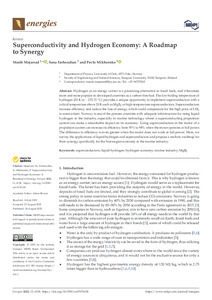Superconductivity and Hydrogen Economy : A Roadmap to Synergy
Mojarrad, Masih; Farhoudian, Sana; Mikheenko, Pavlo (2022-09)
Mojarrad, Masih
Farhoudian, Sana
Mikheenko, Pavlo
09 / 2022
6138
Julkaisun pysyvä osoite on
https://urn.fi/URN:NBN:fi:tuni-202210037393
https://urn.fi/URN:NBN:fi:tuni-202210037393
Kuvaus
Peer reviewed
Tiivistelmä
Hydrogen as an energy carrier is a promising alternative to fossil fuels, and it becomes more and more popular in developed countries as a carbon-free fuel. The low boiling temperature of hydrogen (20 K or −253.15 °C) provides a unique opportunity to implement superconductors with a critical temperature above 20 K such as MgB2 or high-temperature superconductors. Superconductors increase efficiency and reduce the loss of energy, which could compensate for the high price of LH2 to some extent. Norway is one of the pioneer countries with adequate infrastructure for using liquid hydrogen in the industry, especially in marine technology where a superconducting propulsion system can make a remarkable impact on its economy. Using superconductors in the motor of a propulsion system can increase its efficiency from 95% to 98% when the motor operates at full power. The difference in efficiency is even greater when the motor does not work at full power. Here, we survey the applications of liquid hydrogen and superconductors and propose a realistic roadmap for their synergy, specifically for the Norwegian economy in the marine industry.
Kokoelmat
- TUNICRIS-julkaisut [16983]
